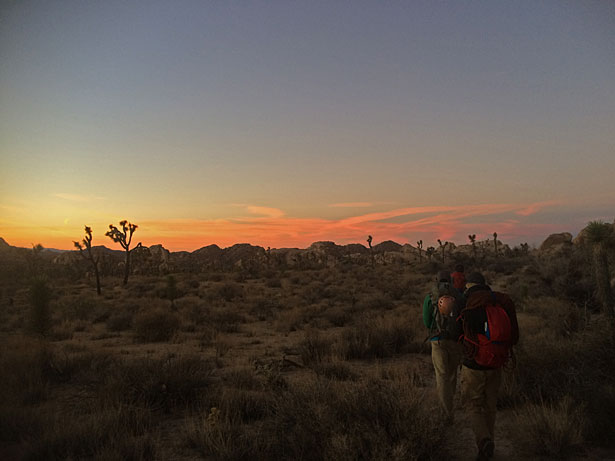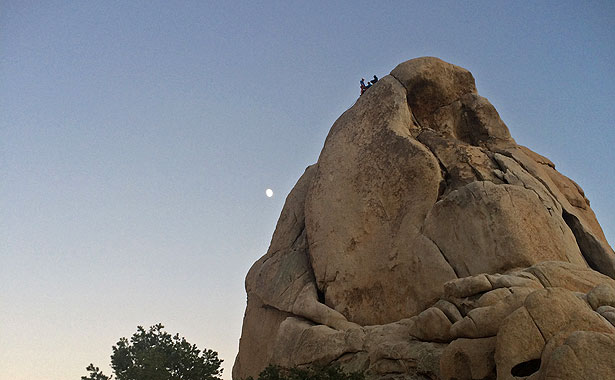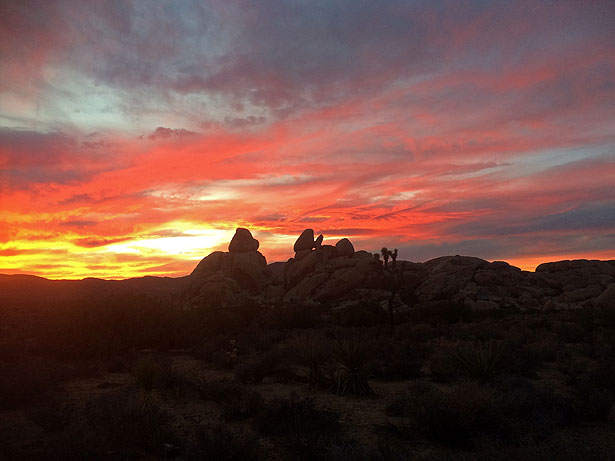Joshua Tree Redux
The last time I visited Joshua Tree was in 2009. We’d been in So Cal for some concerts, and when they were over we had two days to spend there before heading back home. I left that trip with the impression that it was a stunning place, but the climbing could be summed up as all the hassles of multipitch climbing for the rewards of a single pitch. When I go out for a day of cragging, I like to climb lots of routes. (Eight to ten pitches is what I’d consider a solid day) On that last trip, we got frustrated by the lack of bolted anchors and the time suck of having to top out climbs, find the descent, rappel and do it all over again. I wasn’t keen to return any time soon.
In mid-November, I had the opportunity to take an AMGA Rock Guide Course there for ten days, and I left this time with a more favorable impression, though I still stand by our original thoughts.
At first I thought the lack of bolted anchors was due to an aversion to bolts in general, this being a more old-school area. But over the course of ten days, I saw bolts everywhere. Bolts on multipitch climbs, bolted boulder problems, random 4-bolt routes in descent gullies. Literally bolts everywhere, just not at the top of the climbs. I get that bolted anchors would change the character of some of these pitches, but at the same time, it’s 2016, topping stuff out just isn’t cool anymore. Who has time for that?
It’s chossy and sharp. For the course, we weren’t always climbing the most classic routes, which meant we got to climb some chossy and scabby routes. In fact, when we visited the Comic Book area, “scabby” became the word of the day. Now of course there is some great rock in the park, but you definitely have to seek it out. Much like Red Rocks, it’s best to stay away from the white rock, and seek out the dark brown stuff. I was also surprised at how much hollow rock there was, and it seemed almost every pitch I led had suspect gear placements due to poor rock quality.
But of course, the hang is awesome. It truly is a wonderland of rocks, and an amazing place to disconnect from modern society and feel the natural rhythms of the place. Standing on top of a dome as the moon rises, the feel of the sharp crystals on your skin, the trees in all their convoluted and unique forms, no two alike. The magical sunrises and sunsets. All the hidden nooks that are waiting for the curious explorer. The vistas across open desert of more monzogranite domes rising from the sand.
By the time I left, I came to appreciate the climbing for what it is: a testament to a time when the original dirtbags were chasing the endless climbing season, wintering over in the best option they had. It’s not a place to crush out a bunch of pitches, but a place to appreciate what it must have been like to climb these routes back in the 60s and 70s, many of which feel stout for the grade even now with gear that’s light years ahead of what the first ascentionists were using.
It’s still not high on my list of areas to visit, there are just too many places I haven’t been, and there’s too much climbing between here and there that’d I’m more interested in, but I will definitely be back and look forward to exploring more of this desert oasis when I return.
Bulldog Creek Dog Walk (IV WI 4+)
Hayden Carpenter and Tom Bohanon recently repeated an obscure ice climb on the south side of Mt Sopris. Given a brief mention in Jack Robert’s ice guide, Bulldog Creek Walk is described as being 100 meters of WI 4. What they found was seven pitches of ice in a remote setting that makes for one […]
Connect with Us


















Recent Comments